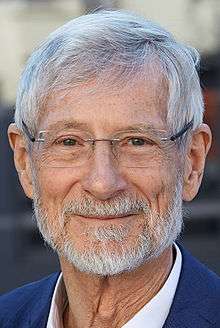Erwin Hochmair
Erwin Hochmair (born 1940) is an Austrian electrical engineer whose research focuses in the fields of biomedical engineering and cochlear implant design. He has been a professor at the Institute of Experimental Physics, University of Innsbruck since 1986. He has authored and co-authored over 100 technical articles and holds about 50 patents.[2][3] He is the founder and owner of the medical device company MED-EL.
Erwin S. Hochmair | |
|---|---|
 | |
| Born | 1940 |
| Nationality | Austrian |
| Spouse(s) | Ingeborg Hochmair |
| Awards | IEEE Best Paper Award Holzer-Preis Erwin Schrödinger Prize |
| Scientific career | |
| Fields | circuit design, signal processing, cochlear implant design[1] |
Biography
Hochmair was born in Vienna in 1940. He received his Dipl.-Ing. and D.Tech. degrees in electrical engineering from the Technical University of Vienna in 1964 and 1967, respectively. He joined the Institute for Physical Electronics of the Technical University of Vienna in 1965, where he taught courses on linear integrated circuits and circuit design. He worked as a research associate at Marshall Space Flight Center, in the U.S. from 1970 to 1972 where he designed analog integrated circuits in CMOS technology.[4] He was a visiting associate professor at Stanford University in 1979.
Cochlear implant design
In 1975, the Austrian Research Council supported Hochmair's cochlear implant project by a grant of 110,000 ATS, roughly equivalent to $11,000 USD. Together with his wife Ingeborg Hochmair, who holds several degrees in electrical engineering, he designed a device that was able to stimulate the fibers of the auditory nerve at several locations within the cochlea. A previous implant design by William F. House could only stimulate cochlea at one site.
They built a multichannel intra-cochlear electrode, and developed all the implantable and the external electronics for the transcutaneous transmission, the coding and decoding of circuits and the electrode driving circuitry while trying to minimize the power consumption. On December 16, 1977 he was part of the team responsible for implanting the first single-channel cochlear implant.[5] They established MED-EL in 1989, a cochlear implant manufacture company.[6] In 2013, Ingeborg Hochmair won the coveted Lasker Award, often considered the "American Nobel Prize," for this development.[7]
Awards and honors
Hochmair received the best paper award at the International Solid-State Circuits Conference in 1977 and the Erwin Schrödinger Prize of the Austrian Academy of Sciences in 2003.[8] He has been awarded an honorary doctorate in medicine from the Technical University of Munich in 2004[3] and received the Holzer-Prize of the Vienna Technical University.
References
- Zierhofer, C.M.; Hochmair, E.S. (1990). "High-efficiency coupling-insensitive transcutaneous power and data transmission via an inductive link". IEEE Transactions on Biomedical Engineering. 37 (7): 716–722. CiteSeerX 10.1.1.512.1437. doi:10.1109/10.55682. PMID 2394460.
- "Hörimplantate-Pionier Erwin Hochmair verabschiedet". uibk.ac.at. September 25, 2009.
- "Erwin Hochmair". hindawi.com.
- "Journey to Developing MED-EL's Cochlear Implant: Interview with Dr. Ingeborg and Professor Erwin Hochmair, Founders of MED-EL". cochlearimplantonline.com. December 19, 2012.
- Henkel, Gretchen (1 April 2013). "History of the Cochlear Implant". ENT Today. The Triological Society. Retrieved 19 July 2016.
- "The Hearing Implant Company". medel.com.
- Altman, Lawrence K (9 September 2013). "Lasker Awards Go to Five Scientists and Gateses". The New York Times. Retrieved 8 October 2013.
- "Preisträger und Preisträgerinnen des Erwin Schrödinger-Preises" (in German). stipendien.at. Archived from the original on 2017-07-02. Retrieved 2013-03-30.